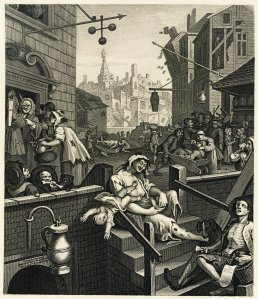Somewhere deep in his Letters, Wallace Stevens admits that he never liked Christmas much because the holiday never lives up to advance billing. Being of a similar mind, I’m glad the man is not alive to see that Samsung commercial where this minor actor named Dax Shepard (yes, sentient human parents named him Dax) and his pregnant wife decorate their awful Silver Lake hill cube. (Google it if you want to rot inside a little.) And for a variety of boring reasons I’m not drinking this go-round, which makes the season even more tedious, so to stave off boredom-induced madness, I’ve scrawled some things on the digital wall . Get out your knife and fork and dig in.
- Eliza Griswold is a wonderful young American poet. Like most poets, her readership is appallingly limited. This is her page at the Poetry (magazine) Foundation. You can buy her debut volume, Wideawake Field, here.
- Turns out Twitter isn’t just for beefing about sports and harassing female journalists. Some writers have started experimenting with it as a platform for bursts that are worth reading closely, and right now the best Twitter scrivener going is Jeet Heer (@HeerJeet). Here is a link to his aptly titled “A Twitter Essay about Twitter Essays.” Writes Heer: “These are essays in the classical French sense of the word: essaying a topic: an attempt, a provisional thought, a notebook entry.” Imagine if Montaigne had an iPhone!
- Denis Johnson has a new book out. Set in post-9/11 Africa, it is called The Laughing Monsters. Just ordered my copy. It will be very good. Do you know how I know that? Because Denis Johnson wrote it.
- Sickened by all the Christmas saccharinalia on the radio? Here is TGR favorite Dwight Yoakam covering a Tom Jones song:
- Paul Thomas Anderson has turned Thomas Pynchon’s novel Inherent Vice into what looks like a pretty good movie. But you should still read the book. It’s not Gravity’s Rainbow–it won’t kill you, unlike GR, which is much duller than its fame suggests. Want to read a huge Pynchon? Pick up Mason & Dixon.
- Oh hey, David Lynch is rebooting Twin Peaks. Guess who has two thumbs and doesn’t care? *raises and tilts both thumbs* This guy! The show was leaden and lethargic the first time, but I had to pretend to like it during college and grad school, because all my friends said they adored it. Spoiler alert: Audrey died of meta-boredom.
- After putting off Graham Greene’s The Power and the Glory (1940) for years, I’m finally thigh-deep in its cold currents. Theory as to at least part of Greene’s genius: no novelist is better–though a few are just as good–at subtly using his characters’ psychological states to form the epistemological tenor of the narrative universe, without employing first-person narration or hammy metaphors. For stretches of his best books, a mind shades a world that is still far more than that single mind. This is not Ruskin’s pathetic fallacy: the encompassing world remains ontologically other, it is just that we access it through such masterful filtrations. In other words, Greene takes free indirect style to the VIP level.
- Before Tinder and OK Cupid and the less libidinous social-media platforms arose to try and distract us from our natural state of crawling loneliness, some mad souls kept the lights on by writing stuff like Notes from Underground (Dostoevsky’s idealist jilted and horrified by the impossibility of perfecting mankind) and In Memoriam A.H.H., Lord Tennyson’s at-times-unbearable cry of anguish over the early death of his best friend. While some associate professors might disagree regarding the latter, neither text is sexual or romantic; both speak to and from within the marrow-grade loneliness one feels when sitting in front of a Mark Rothko painting or listening to Astral Weeks. If you can get through In Memoriam without weeping a couple times, get thee to a doctor.
- You’ll weep for the sins–the ongoing sins–of America if you read “The Case for Reparations,” the 2014 essay that announced Ta-Nehisi Coates as one of the language’s great young essayists. Erudite, methodical, heart-stopping.
- Check out my former colleague Robert Samuels’s eminently readable Why Public Higher Education Should Be Free (2013). Samuels’s core thesis is that instead of funneling billions into colleges and universities via federal loans, grants, and byzantine tax breaks which individual students then use to pay tuition, the money could be given directly to schools, who would in turn offer tuition-free education. Sounds bracingly simple, right? But then creditors, including the federal government, would lose that deep, swift stream of interest payments on all those loans, loans that, unlike every other form of consumer debt, cannot be refinanced or discharged in bankruptcy. (My own from graduate school are locked in at 6.8 percent, more than double the prime rate as reported by the Wall Street Journal.) If you die, your next of kin are on the hook for the balance. And that’s why Samuels’s book, smart and humane as it is, will never affect education policy in the current American political economy.
- The Washington Post’s Radley Balko has the best journalist name, and his book Rise of the Warrior Cop will scare the bejesus out of you. It is a chilling chronicle of the United States’ ongoing decline into a threadbare security state where carbines, tear gas, and razor wire protect the ruling ten percent from the rest of us when we aren’t busy fighting over Black Friday sales.
- Finally, here is a thing that is funny, one of the best sight/editing gags from The Simpsons:

May the new year leave you in peace, dear general readers.

